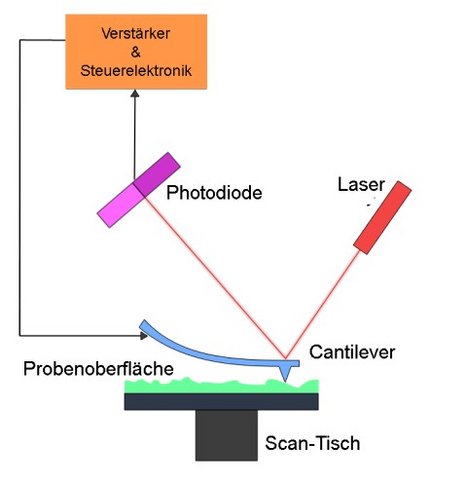
Measuring principle
The sample is scanned at a small distance using a fine tip on a microscopically small leaf spring (cantilever). The cantilever bends due to the interaction forces (order of magnitude: nN) between the tip and the sample. The tip, which is ideally mono-atomic, is moved line by line over the sample with the aid of piezoceramic actuators. In 'contact mode', the cantilever is guided over the sample with a previously selected force. In 'non-contact mode', the cantilever is made to vibrate and the frequency shift is measured as it approaches the sample. The interaction variable can be kept constant via a control loop. The manipulated variable of the control loop, represented as a function of the x and y position of the probe, provides a contour image of a constant interaction variable. For homogeneous samples, this provides a good approximation of the actual topography. In order to prevent rapid contamination of the surface, most measurements are carried out in a vacuum.
The control loop
In order to keep the distance between the cantilever and the sample surface constant, the normal force FN is kept constant by an electronic control circuit. The control circuit measures the current force FN (actual value) and compares it with the previously set value (target value). If these deviate from each other, the controller attempts to eliminate the difference via its output (control value). The change specifications are transmitted via the piezo elements, which can move the cantilever in the three spatial directions. The controller settings depend on the entire system and therefore cannot be set to any desired level. In addition, the control loop itself is already an oscillating system with a limit frequency above which natural oscillations occur. These natural oscillations can damage the cantilever and the sample. The scanning speed can have a very strong influence on the quality of the AFM image. Too high a speed usually degrades the image. It must also be remembered that the control speed is closely linked to the scanning speed.
The cantilever
According to electron micrographs, the cantilevers used have radii of curvature of a few 10 nm at the tip. However, since atomic resolution can be achieved on the AFM, this can only be explained by the presence of so-called mini-tips. This means that almost the entire force effect is only generated via the mini-tip closest to the sample. However, the arrangement of these mini-tips on the cantilever is by no means stable, but can change in the course of the measurements. This can have both positive and negative effects on the resolution and the general quality of the images. The cantilevers are usually made of silicon or the harder silicon nitride.
For further information see here.